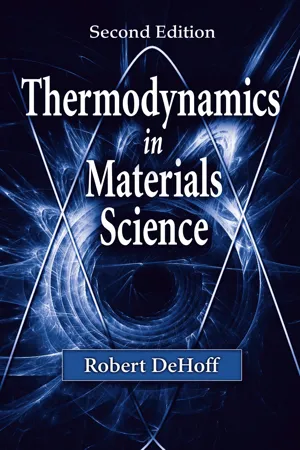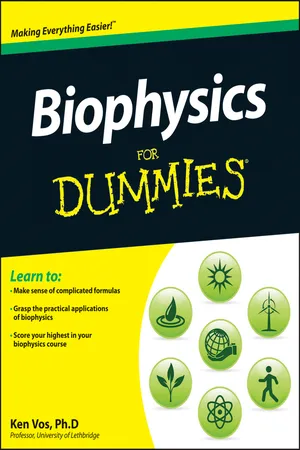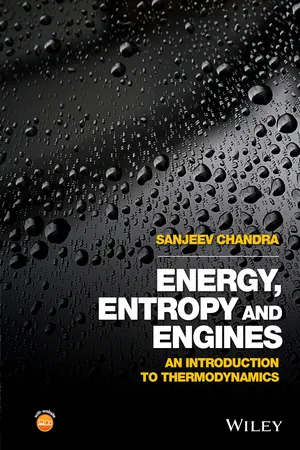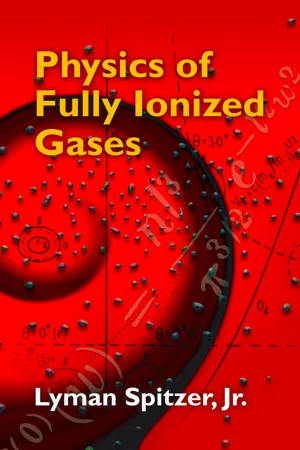Physics
Equilibrium
Equilibrium in physics refers to a state where the net force and net torque acting on an object are both zero, resulting in no acceleration or rotation. It can occur in various forms, such as static equilibrium where an object is at rest, or dynamic equilibrium where it moves at a constant velocity.
Written by Perlego with AI-assistance
Related key terms
Related key terms
1 of 4
Related key terms
1 of 3
5 Key excerpts on "Equilibrium"
- eBook - ePub
- Robert DeHoff(Author)
- 2006(Publication Date)
- CRC Press(Publisher)
The idea that a system changes toward some final ultimate condition and, once there, remains in that condition unless acted upon by some external agent is a familiar one. Such a system is said to come to Equilibrium or approach its Equilibrium state. The specific nature of that state depends upon the chemical and energy content of the system and that of its surroundings. A system comes to Equilibrium in given surroundings. It may only be disturbed from its Equilibrium state by changing the state of its surroundings.A simple application of this idea is illustrated in Figure 5.1 . The system acted upon by a set of mechanical forces shown comes to Equilibrium when it arrays itself with respect to the forces so that they are in balance. The mathematical statement that describes this condition is particularly simple for this mechanical system.The vector sum of the forces acting on the point P is zero:FIGURE 5.1 A simple mechanical system in Equilibrium. The vector sum of the forces acting at P is zero.which implies:(5.1)= 0∑ iF i(5.2)= 0 ;∑ iFi x= 0 ;∑ iFi y= 0∑ iFi zwhere the subscripts x, y, and z represent components of the force vectors resolved in some orthogonal coordinate system, and the summation over the index i is taken over all of the forces acting on the body. Once the system has found the position in space O which achieves this balance, it will remain fixed in that position until one of the weights is changed. Furthermore, if the system is displaced from its Equilibrium position, e.g., if the body is moved to any position in the neighborhood of O, it will return to O.In thermodynamics, the influences that operate to modify the condition of a system are more general than mechanical forces. Nonetheless, the intuitive notion of an Equilibrium condition also applies to such systems. This idea of an Equilibrium state has two components:- It is a state of rest.
- It is a state of balance.
The first component means that the condition of the system, no matter what it might be, is time independent. The system has achieved a stationary state. No changes can occur in a system that has come to Equilibrium except by the action of influences that originate outside the system/surroundings complex. The second component to the concept means that if the system is perturbed from its Equilibrium condition by some outside influence, it will return again to the same condition when it again comes to rest. - eBook - ePub
- M. Rashad Islam, M. Abdullah Al Faruque, Bahar Zoghi, Sylvester A. Kalevela(Authors)
- 2020(Publication Date)
- CRC Press(Publisher)
3 Equilibrium of Particle and Rigid Body3.1CONCEPT OF EquilibriumFrom Newton’s third law of motion, we know that every action has its own and opposite reaction. That means, if you apply a force to a wall it will react with an equal amount of force on you, if the wall is not moving (rigid). Therefore, every action is equal to its reaction in any direction. This is called the Equilibrium condition. If we sum up this action and reaction in a direction, it will be zero as these two are numerically equal but the signs are opposite. Thus, we can write the following three equations for two-dimensional conditions:∑F x= 0(the summation of forces along the x -direction (horizontal) is zero)∑F y= 0(the summation of forces along the y -direction (vertical) is zero)∑ M = 0(the summation of moment at any point about any axis perpendicular to the plane is zero)Figure 3.1a shows a body is experiencing forces from different sides. The summation of forces in any direction must be zero to be in Equilibrium. Figure 3.1b shows an inclined structure which is in Equilibrium.3.2PARTICLE VERSUS RIGID BODYA particle is a body of infinitely small volume and is considered to be concentrated at a point. Every point in a particle can be considered to have the same characteristics.A rigid body is one which does not deform under the action of the loads or the external forces. In the case of a rigid body, the distance between any two points of the body remains constant, when this body is subjected to loads. Examples of a particle and a rigid body are shown in Figure 3.2 .3.3IDEALIZATION OF STRUCTURESReal structures are complicated and have different features in terms of loading application, loading distribution, support restrictions, etc. These conditions are simplified for analyzing the structures using paper and pencil or a computer. A simplified version of the structures is known as the idealized structure. - eBook - ePub
- Ken Vos(Author)
- 2013(Publication Date)
- For Dummies(Publisher)
If your friends produce a tension greater than 67.5 pounds (300 newtons) in the rope, then Larry will slide off the table and fall into the swimming pool below. A 10-pound fishing line wouldn’t work, so hopefully you have a bigger rope in your home.Static systems are in static translational Equilibrium. No matter how different a problem may look from the solutions in this section, if a system is in static translational Equilibrium, then the biophysics is the same and the steps involved in solving it are the same.Turning to Static Rotational EquilibriumA biological system that’s in static Equilibrium, in addition to not moving and being in static translational Equilibrium (which I discuss in the previous section), is also in static rotational Equilibrium. Static rotational Equilibrium means that the angular acceleration of the biological system is zero, and according to Newton’s second law, the net torque acting on the system must be zero.Think of changing a flat tire: You place the tire wrench on the lug nut and pull, producing a torque on the lug nut. (Torque tries to make an object spin faster or slower — see Chapter 4 for a complete discussion.) Unfortunately, the lug nut has rusted to the hub, and the friction force produces a countering torque in the opposite direction. The two torques add up to zero, and the lug nut doesn’t move.An example of a stationary object not in rotational Equilibrium is you on a swing moving back and forth. When the swing reaches its highest position, you stop momentarily. You and the swing are stationary, but gravity is producing a torque, which causes you to start swinging in the opposite direction.Solving rotational Equilibriums Solving static rotational Equilibrium problems also involves satisfying these three equations. The mathematical formula for static rotational Equilibrium is - eBook - ePub
Energy, Entropy and Engines
An Introduction to Thermodynamics
- Sanjeev Chandra(Author)
- 2016(Publication Date)
- Wiley(Publisher)
If we disturb a system in Equilibrium it will pass through a stage of non-Equilibrium until it reaches a new Equilibrium state. A ball at rest on a table is at Equilibrium, but pushed off the edge it will fall and bounce on the floor until it is comes to rest again. The transition from one Equilibrium state to another is important because we can use the system to do useful work while it is in non-Equilibrium. A ball cannot lift a weight while it is resting on a table or on the floor, but we could design a mechanism that uses the momentum of the ball while it is falling to do work. A tranquil lake cannot drive a hydroelectric turbine but a waterfall can.Thermodynamics cannot be used to analyse a system whose properties are changing with time. It is possible to study time-varying systems using the principles of dynamics, fluid mechanics and heat transfer, but thermodynamics only describes systems at Equilibrium. This information is still valuable: in the case of a ball falling from a table to the floor, we can calculate the potential energy at both the initial and final Equilibrium states and their difference will gives us the maximum possible amount of work that the ball could do. This is the approach followed in thermodynamic analysis, where we calculate the difference in properties between two Equilibrium states and use that to set bounds on the energy transfers that occur during the intervening process. Therefore, predicting the properties of a system once it has reached Equilibrium is a very important task in thermodynamics.When dealing with control volumes it is often useful to make the assumption of local thermodynamic Equilibrium, which means that if we take an infinitesimally small volume of fluid from anywhere within the system and isolate it we would not observe any change with time in its properties. With this assumption we can measure the properties of a volume of fluid when it enters the control volume and again when it leaves, and from their difference deduce the processes occurring in the system.It is important to understand the difference between steady state and Equilibrium. A system that is interacting with its surroundings, but whose properties are not changing with time, is at steady state. An isolated system with constant properties is at Equilibrium. When we open a water tap over a sink the water level in the sink rises until the rate at which water flows out through the drain equals the rate at which it flows in, at which time the system has reached steady state (Figure 2.14 a). The mass of water in the sink remains constant even though there is constant flow in and out of it. If we close the drain, turn off the tap and leave the sink isolated from the surroundings, it will be at Equilibrium (Figure 2.14 - eBook - ePub
Physics of Fully Ionized Gases
Second Revised Edition
- Lyman Spitzer(Author)
- 2013(Publication Date)
- Dover Publications(Publisher)
CHAPTER 4Equilibria and Their Stability
When all the macroscopic quantities characterizing a plasma are constant in time, the plasma is said to be in Equilibrium. In the laboratory and in astrophysics particular interest attaches to a “confined” plasma, which is held in a steady state within a finite region, surrounded by a magnetic field. Because of their possible importance in the controlled release of thermonuclear power, confined plasmas have received much attention during the last few years and many possible magnetic configurations have been analyzed.The existence and nature of Equilibrium states of a plasma and the extent to which these states are stable can be analyzed with the macroscopic equations given in Chapter 2, without recourse to the more powerful but vastly more complex treatment involving the Boltzmann equation and the velocity distribution function. We shall analyze here the equilibria expected in relatively simple geometries, and shall deal very briefly with the stability problem in order to indicate the type of instabilities that may arise in an ionized gas. The first section discusses the principles involved, while subsequent sections apply these principles to various plasma configurations.4.1 Principles of Stable Equilibrium
For a system to persist in a particular state it must satisfy two conditions: (a) it must be in Equilibrium, and (b) the Equilibrium must be stable. A fully ionized gas will be in Equilibrium if it satisfies equations (2-11) through (2-19) with all the time derivatives set equal to zero. It will be stable if all types of infinitesimal perturbations lead to damped oscillations about this Equilibrium state, and unstable if one or more types of perturbation grow exponentially. We examine each of these two conditions in more detail.The analysis of any Equilibrium state is straightforward. If we neglect terms of order m e /m i , equations (2-20) and (2-21) are the ones that must be satisfied. A confined plasma is possible in Equilibrium only if the resistivity, η, vanishes; alternatively one might consider a steady state in which the plasma slowly diffuses outwards as a result of finite resistivity, while some source of new gas maintains the density uniform. We shall here neglect the ηj term in equation (2-21), in which case this equation gives a relationship between E and v but is not required for determining p , j and B
Index pages curate the most relevant extracts from our library of academic textbooks. They’ve been created using an in-house natural language model (NLM), each adding context and meaning to key research topics.
Explore more topic indexes
Explore more topic indexes
1 of 6
Explore more topic indexes
1 of 4




